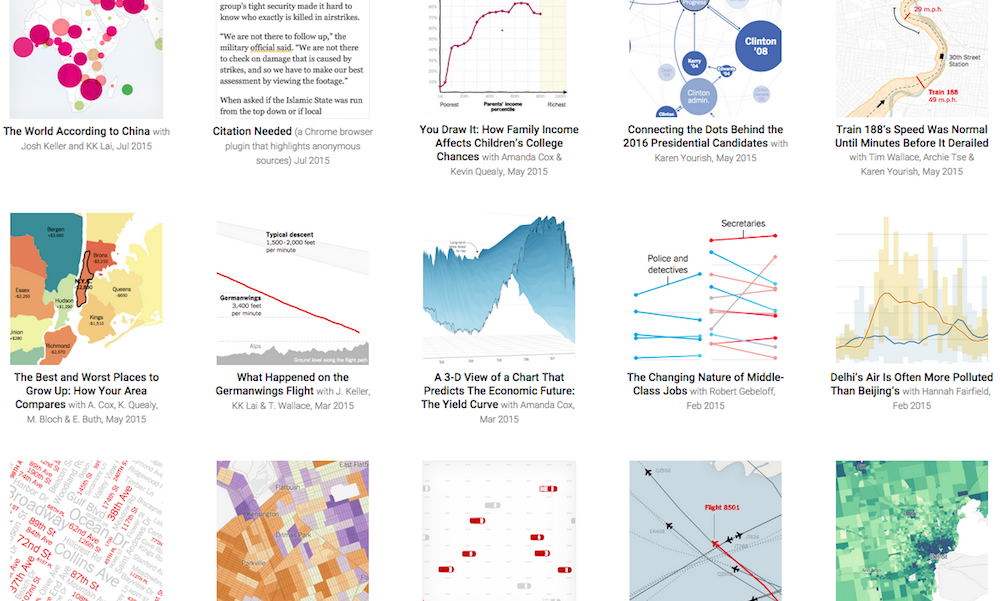In order to sprinkle some star dust into the contents of my book I’ve been doing a few interviews with various professionals from data visualisation and related fields. These people span the spectrum of industries, backgrounds, roles and perspectives. I’ve only scratched the surface with those I have interviewed so far, there’s a long wish list of other people who I haven’t approached yet but will be doing so. My aim is to publish a new interview each week through to the publication of my book around April/May 2016 so look out for updates!
I gave each interviewee a selection of questions from which to choose six to respond with quick, instinctive answers. This latest interview is with Gregor Aisch, graphics editor at The New York Times. Thank you, Gregor!
Q1 | What is the single best piece of advice you have been given, have heard or have formed yourself that you would be keen to pass on to someone getting started in a data visualisation/infographics-related discipline?
A1 | Labelling is the black magic of data visualization.
Q2 | When you begin working on a visualisation task/project, typically, what is the first thing you do?
A2 | Get the data in shape! If it comes in a weird format, like thousands of little JSON files, I will write a quick script (usually Python or Node) to get it into a nice structured format. The next step would be to fire up R Studio and do some quick plots to see where this could go.
Q3 | With deadlines looming, as you head towards the end of a task/project, how do you determine when something is ‘complete’? What judgment do you make to decide to stop making changes?
A3 | When a project drags on for too long, at some point you just want to publish the thing and move on with your life. That’s the time when I stop thinking about what niceties could be added and just finish it. There is usually tons of work left at this point.
Q4 | Given the rich capabilities you and your colleagues possess, the bar is set quite high in terms of the ambitions of what form and what function your visualisation and infographic work can take. Innovation is important, but sometimes you see work out there that is evidence of people doing things just because they can, rather than because they should. How do you (individually and within the team) maintain clarity of focus and preserve the discipline of avoiding unnecessarily innovation?
A4 | I don’t think there is such a thing as “unnecessary innovation”. If someone wants to try something new. It would be quite boring to produce only bar charts for the rest of your life. The publishing medium changes rapidly, web browsers evolve, new devices change the way people consume stories. With every project you learn something new, so it’s only natural to re-think what you do once you start over again.
Q5 | As you know (more than most!) there is a lot of science underpinning the use of colour in data visualisation. There is also, however, a lot that can be achieved through applying common sense. What is the most practical advice you’ve read, heard or have for relative beginners in respect of their application of colour?
A5 | If you want a nice custom color palette, use my color palette tool. The bottom line is that this tool will correct the steps in perceived lightness, which is what you want in a balanced palette. It also allows you to experiment with bezier interpolation to make intermediate color steps look better. Ah, and you should definitely check the palette with ColorOracle, a tool that shows you how your graphic looks like for colorblind readers.
Q6 | What advantages do you think working in a journalistic setting has in terms of ongoing development of your data visualisation/infographic capabilities?
A6 | There are tons of advantages of working in a newsroom with some of the smartest people in the world! In terms of my data vis capabilities I would say that learning the journalistic “mindset” is something that has helped me the most. While I was freelancing I had started dozens of projects that I never completed. The reason is probably that most of them where way too ambitious or completely unrealistic. Being a journalist means that no matter what you do, you focus on publishing from day one. You want to do amazing work, but you also want to get it done! Finding the right balance between these two goals is something journalists are incredibly good at!

